
Mysore, officially Mysuru, is a metropolitan city in the southern Indian state of Karnataka. It is the state's third-most populous and is one of the cleanest cities in India according to Swachh Survekshan. It is the seat of the Wadiyar dynasty and was the capital of the Kingdom of Mysore for almost six centuries, from 1399 until 1947. It is currently the headquarters of Mysore district and Mysore division. Known for its heritage structures and palaces, including the famous Mysore Palace, and noted for its culture, Mysore is popularly known as the "City of Palaces", the "Heritage City", and the "Cultural Capital of Karnataka". For its pristine and calm ambience, it is also known as "Pensioners' Paradise".
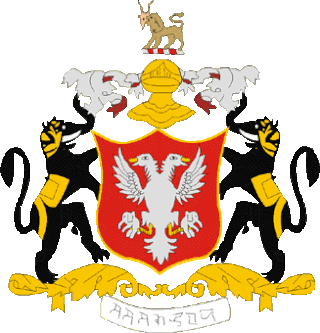
The Wadiyar dynasty, is a late-medieval/early-modern South Indian Hindu royal family of former kings of Mysore from the Urs clan originally based in Mysore city.

The Chamundi Hills are located 13 km east of Mysore, Karnataka, India. The name comes from the Chamundeshwari Temple at the peak. The average elevation is 1,060 metres (3,480 ft).

Chamarajendra Wadiyar X was the twenty-third Maharaja of Mysore between 1868 and 1894.

Mysore district, officially Mysuru district, is an administrative district located in the southern part of the state of Karnataka, India. It is the administrative headquarters of Mysore division. Chamarajanagar District was carved out of the original larger Mysore District in the year 1998. The district is bounded by Chamrajanagar district to the southeast, Mandya district to the east and northeast, Kerala state to the south, Kodagu district to the west, and Hassan district to the north.
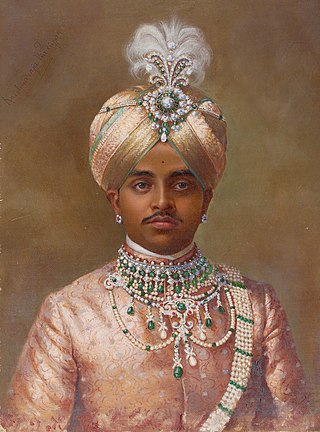
Krishnaraja Wadiyar IV (Kannada: ಶ್ರೀ ನಾಲ್ವಡಿ ಕೃಷ್ಣರಾಜ ಒಡೆಯರು; 4 June 1884 – 3 August 1940) was the twenty-fourth Maharaja of Mysore, reigning from 1902 until his death in 1940.

The maharaja of Mysore was the king and principal ruler of the southern Indian Kingdom of Mysore and briefly of Mysore State in the Indian Dominion roughly between the mid- to late-1300s and 1950. The maharaja's consort was called the maharani of Mysore.

Srikanthadattā Narasimharājā Wadiyar was an Indian royal, politician, and fashion designer, who served as Member of Parliament from Mysore. He was the son of Maharaja Jayachamarajendra Wadiyar, the last king of Mysore.
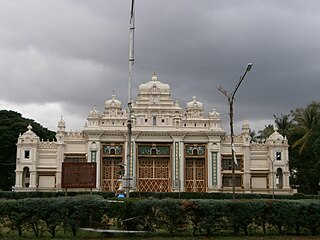
Sri Jayachamarajendra Art Gallery, commonly known by its former name Jaganmohana Palace, is a royal mansion, arts museum and auditorium, and formerly an alternative royal residence of the ruling maharaja of Mysore, located in Mysore, India, about 200m (600ft) to the west of Mysore Palace. Began in 1856 and completed in 1861, the palace is one of the oldest modern structures in Mysore.

The Rajendra Vilas is a palace-hotel atop Chamundi Hills in Mysore, Karnataka, India. It is now closed and in a state of neglect and can only be visited with prior permission.

Mysore Dasara is the Nadahabba of the state of Karnataka in India. It is a 10-day festival, starting with nine nights called Navaratri and the last day being Vijayadashami. The festival is observed on the tenth day in the Hindu calendar month of Ashvina, which typically falls in the Gregorian months of September and October.

The Golden Throne or Chinnada Simhasana or Ratna Simhasana in Kannada, was the royal throne of the rulers of the Kingdom of Mysore. It is one of the main attraction of Mysore Palace. It is kept for public viewing only during Dasara festival and on the rest of the days, it is disassembled and kept in safe lockers of the palace.
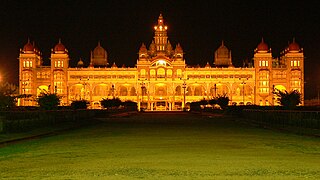
Mysore is a city in the state of Karnataka, India. It is known as the cultural capital of Karnataka. Mysore was the capital of the Wodeyar kings who ruled over the Mysore Kingdom for many centuries. Wodeyars were great patrons of art and music and have contributed significantly to make Mysore a cultural centre. Mysore is well known for its palaces, museums and art galleries and the festivities that take place here during the period of Dasara attract a worldwide audience. Mysore has also lent its name to popular dishes like Mysore Masala Dosa and Mysore Pak. Mysore is also the origin of the popular silk sari known as Mysore silk sari and has also given rise to a popular form of painting known as Mysore painting.

Krishnaraja Wadiyar III was the twenty-second maharaja of the Kingdom of Mysore. Also known as Mummadi Krishnaraja Wadiyar, the maharaja belonged to the Wadiyar dynasty and ruled the kingdom for nearly seventy years, from 30 June 1799 to 27 March 1868. He is known for his contribution and patronage to different arts and music during his reign. He was succeeded by his adopted son, Chamarajendra Wadiyar X.
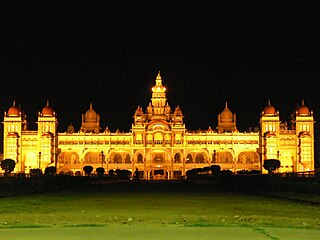
The Mysore Dasara 2013 is the 403rd edition of the annual royal festive gala event, a show of pomp and tradition that is held in the Mysore city in Karnataka, India for 10 days. The festival is called the Navaratri (meaning nine nights or Dussehra or Vijayadashami which conforms to the bright half of the month of Ashvin, from pratipadathithi to navamithithi in the Hindu calendar corresponding to 5 to 13 October during 2013. The festival is also called Nada Habba in Kannada language. The first day of the nine-day festivity started on 5 October with the traditional and religious special puja performed to Goddess Chamundeshwari in the Chamundi Temple on top of the Chamundi Hill, which forms the backdrop to the city; the temple was beautifully decorated with flowers and tourist from Gujarat, Rajasthan and other states enthralled the audience with their bhajan singing. On this occasion, floral tribute wa offered to the goddess by Jnanpith Award winner Chandrashekhara Kambara and festivities will continue for ten days. The ninth day of the festival is a special event called the Mahanavami when the royal sword is worshipped and taken in a procession of elephants, camels and horses. The festival concludes on 14 October on the dashami day with the grand finale of Jambusavari with the idol of Chamundeshawri set in a golden howdah mounted on a richly caparisoned elephant. The procession is taken through the streets of the city and ends in the Banni Mantap where, in the evening, a torch light parade is held. Symbolically, the festival represents the victory of good over evil.

The group of temples at the Amba Vilas Palace in Mysore were constructed during various periods by the kings of the Wodeyar dynasty who ruled the Kingdom of Mysore from about 1399 to 1947 A.D. These temples are protected monuments under the Karnataka state division of the Archaeological Survey of India.
Raja Wodeyar I was the ninth maharaja of the Kingdom of Mysore. He was eldest son of Chamaraja Wodeyar IV, the seventh maharaja of Mysore. He ruled from 1578, after his cousin Chamaraja Wodeyar V's death, until his death in 1617.

Yaduveer Krishnadatta Chamaraja Wadiyar is an Indian royal and the great-grandson of Maharaja Jayachamarajendra Wadiyar. He was adopted by Pramoda Devi Wadiyar, the wife of his great-uncle Prince Srikantadatta Wadiyar fourteen months after the latter's demise on 10 December 2013. Yaduveer Wadiyar was installed as the "Maharaja of Mysore" in a private ceremony in 2015.

Madhuvana Mysore Royal Cemetery is a site in Mysuru where many members of the Wadiyar royal family were cremated. It is located on Mysuru-Nanjangud road, and is on five acres of land. It is also known as "Khasa Brindavan", or "private garden". The cemetery is in the process of becoming a tourist attraction.
Agrahara Circle, officially known as N. Madhava Rao Circle, is a street circle and a suburb in the southern Indian city of Mysore in Karnataka.


























